
Critical Reading: The Steps
This site focuses on understanding how the written language works to convey meaning. Such a
discussion should not, however, downplay the need for good study habits, motivation, and
purpose. Critical reading begins before you open a book. What you are reading and why you are
reading it greatly influence how you read.
The Nature Of The Text: What Are You Reading?
The Working Environment: Where Will You Read?
The Goal or Assignment: How Will You Read?
Three Formats For Discussion: A Quick Reminder
Finally, we can outline steps in the process of critical reading itself.
Steps in Critical Reading
The Nature Of The Text: What Are You Reading?
The more you know about the text and the topic, the better prepared you are to follow references,
anticipate arguments, and understand the discussion.
What book or article are you reading?
•What is the title? In other words, what does the author claim it is about?
•What kind of information or discussion do you anticipate?
•What do you know about the topic? What might you want to know?
•What background reading might you do first?
You can often get a good idea of these matters by scanning the preface or table of contents of a
book, or the subheadings of a chapter or article. Remember that most discussions involve a
number of interrelated issues
Who cares?
•Who has a stake in the issue?
•Who controls the outcome of the issue?
•Who is affected by the issue?
The more you know about the issue before reading, the better prepared you will be to recognize
bias.
Who wrote the text?
•What do you know of the author's goal or purpose?
The text in question may not be consistant with concerns or biases of an author's earlier works or
mirror the author's public statements-- but it might.
•When was it published? Where? By whom?
Information such as this may help you follow references and associations and possibly suggest a
bias. The date of publication can also indicates how up-to-date the information and claims may
be.
See: The Spoken Word: The Base For Writing and Reading
The Working Environment: Where Will You Read?

Where will you work? To concentrate, you must be comfortable. Some students work best when
free of distractions; others work well with distractions.
•Will you read sitting in a chair, at a desk, or elsewhere?
•Does your chair offer good support, your desk sufficient room to work?
•Is the lighting strong enough to illuminate your work, indirect enough to avoid glare, and
adjusted to avoid shadows?
•Are you safe from distractions, whether the telephone, television, roommates, or the
temptations of a full refrigerator.
•What tools and supporting materials will you need to have at hand?
odictionary or other reference material
olab or class notes
opencils, pens, highlighters
onote paper and/or computer.
Finally, note that diet and exercise can be as important to good study habits as efficient time
management and discipline. Energy and a sense of physical well-being are essential for working
effectively and efficiently.
The Goal or Assignment: How Will You Read?
We read differently for different purposes and different forms of accountability. [See: Three Ways
to Read and Discuss Texts]
To know what to look for, you have to know what you want to find. Your reading should therefore
be purposeful: you should know what you are doing, what you want to come away with, and how
you intend to achieve that goal.
How much are you going to read?
•Will you read a specific portion or simply read until you want to stop?
•How many pages are involved? You need to know how far you are going to pace
yourself.
Is there a specific assignment?
•Are you reading for entertainment, to memorize formulas and definitions, to gain a broad
understanding of ideas, to answer questions, or to do exercises?
•Do you need to prepare notes for a paper, memorize terms for a test, or achieve a
general understanding for class discussion?
How will you be held accountable, by yourself and/or by others?
•How will you test your understanding?

•How will someone else test your understanding?
What schedule will you follow?
•When will you work?
•When will you take a break?
•How will you divide the work to fit the allotted time?
•How will you reward yourself along the way?
It is often hard to find time for even short assignments. Reading that you find difficult or boring
may best be divided into a number of shorter periods. The amount of time available, or allotted,
and how you pace yourself will influence the depth of your analysis.
What study techniques will you utilize?
How will you go about the reading process?
•Will you underline, highlight, or make marginal notes?
•Will you take notes, summarize, make diagrams, or do exercises?
Traditional study plans such as SQ3R (Survey, Question, Read, Recite, Review) and PQ4R
(Preview, Question, Read, Reflect, Recite, Review) involve activities such as
•scanning the Introductions and Prefaces
•examining the Table of Contents or headings,
•previewing sections,
•reading abstracts or summaries first,
•asking yourself questions,
•reciting important passages, and
•rereading or reviewing sections.
Activities to force or reinforce understanding include
•preview/survey: scan the overall text to see the nature of the discussion and where it start
and ends
•restate main ideas
•recite
•write a synopsis
Study behaviors such as these alone will not enable you to read more critically, but they can help
maximize your reading efforts. [See A Linguistic Approach To Reading and Writing]
Three Formats For Discussion: A Quick Reminder
For a quick reminder of the differences between a restatement, description, and interpretation [
Three Ways to Read and Discuss Texts ], consider the following nursery rhyme .

Mary had a little lamb,
Its fleece was white as snow,
and everywhere that Mary went
The lamb was sure to go.
A restatement [ Restatement: Reading What A Text Says ] talks about the topic of the original
text, Mary and the lamb.
Mary had a lamb that followed here everywhere.
A description [ Description: Describing What A Text Does ] talks about the story.
The nursery rhyme describes a pet that followed its mistress everywhere.
The interpretation [ Interpretation: Analyzing What a Text Means ] talks about meaning within the
story, here the idea of innocent devotion.
An image of innocent devotion is conveyed by the story of a lamb's devotion to its mistress. The
devotion is emphasized by repetition that emphasizes the constancy of the lamb's actions
("everywhere"…"sure to go.") The notion of innocence is conveyed by the image of a young
lamb, "white as snow." By making it seem that this is natural and good, the nursery rhyme asserts
innocent devotion as a positive relationship.
Three Ways to Read and Discuss Texts
How we discuss a text is directly related to how we read that text. More to the point here, how we read a text is shaped by
how weexpectto discuss it. While you may not be asked to write about texts at school, and probably will not be asked to
write about texts in your job, you must learn how to talk about texts to discover what makes them work.
Reading and Discussion
The follow excerpt (from the sample text ) serves as an example to define three forms of reading and discussion.
In his social history of venereal disease,No Magic Bullet, Allan M. Brandt describes the controversy in the US military
about preventing venereal disease among soldiers during World War I. Should there be a disease prevention effort that
recognized that many young American men would succumb to the charms of French prostitutes, or should there be a
more punitive approach to discourage sexual contact? Unlike the New Zealand Expeditionary forces, which gave
condoms to their soldiers, the United States decided to give American soldiers after-the-fact, and largely ineffective,
chemical prophylaxis. American soldiers also were subject to court martial if they contracted a venereal disease. These
measures failed. More than 383,000 soldiers were diagnosed with venereal diseases between April 1917 and December
1919 and lost seven million days of active duty. Only influenza, which struck in an epidemic, was a more common illness
among servicemen.
You have read this passage, and someone asks you "to write about it." What should you say?
What you write will vary, of course, You might write any of the following:
1. American soldiers in World War contracted venereal disease in far greater number than soldiers of the New
Zealand Expeditionary force, who had condoms.
2. The passage compares the prevention techniques and disease outcomes of American and New Zealand
soldiers in World War I, noting that American soldiers contracted venereal disease in far greater numbers than
soldiers of the New Zealand Expeditionary force, who had condoms.
3. By examining the outcome of various approaches to condom use during World War I, the text argues the need
for honest and realistic approaches to health prevention in the future.
Each of these responses reflects a different type of reading, resulting in a different form of discussion.
The major difference in the discussions above is in what is being discussed.
1. American soldiers in World War Icontracted venereal disease in far greater number than soldiers of the New
Zealand Expeditionary force, who had condoms.
2. The passage comparesthe prevention techniques and diseases of American and New Zealand soldiers in
World War I. It notes that American soldiers contracted venereal disease in far greater numbers than soldiers of
the New Zealand Expeditionary force, who had condoms.
3. By examining the outcomes of various approaches to condom use during World War I, the text makes a case
for the need for honest and realistic approaches to health prevention in the future.

Only the first response is about the topic of the original text: American soldiers. The next two discussions are in some way
about the text. More specifically, the three modes of response mirror our earlier distinction between what a text says,
does, and means.
1. The first discusses the behavior of soldiers, the same topic as the original text. It restates the original
information.
2. The second indicates how ideas or information are introduced and developed. It describes the presentation.
3. The third attempts to find a deeper meaning in the discussion. It interprets the overall meaning of the
presentation.
In each of the responses above, a reader gains, and is accountable for, a different kind of understanding.
•Restatement restating what the text says talks about the original topic
•Description describing what a text does identifies aspects of
•Interpretation analyze what a text means asserts an overall meaning
We can tell which type of discussion we have before us by examining what it talks about.
Example: A Statement
Your doctor tells you to eat less chocolate and drink less beer. A restatement would repeat the statement,
The doctor said I should eat less chocolate and drink less beer.
A description would describe the remark:
The doctor advised me to change my diet.
An interpretation would find underlying meaning in the remark:
The doctor warned me to reduce my calories for the sake of my health.
Only this final discussion attempts to find significance in the examples, that the foods mentioned are high calorie.
Example: Nursery Rhyme
Mary had a little lamb,
Its fleece was white as snow,
and everywhere that Mary went
The lamb was sure to go.
A restatement would talk about Mary and the lamb.
Mary had a lamb that followed her everywhere.
A description would talk about the story within the fairy tale.
The nursery rhyme describes a pet that followed its mistress everywhere.
The interpretation talks about meaning within the story, here the idea of innocent devotion.
An image of innocent devotion is conveyed by the story of a lamb’s devotion to its mistress. The devotion is emphasized
by repetition that emphasizes the constancy of the lamb’s actions (“everywhere”…”sure to go.”) The notion of innocence is
conveyed by the image of a young lamb, “white as snow.” By making it seem that this is natural and good, the nursery
rhyme asserts innocent devotion as a positive relationship.
Note the effort here to offer as much evidence from the text as possible. The discussion includes references to the content
(the specific actions referred to), the language (the specific terms used), and the structure (the relationship between
characters). Try another nursery rhyme yourself.
These ways of reading and discussion, ---restatement,description, andinterpretation---are is discussed in greater detail
elsewhere.
Different Ways Of Reading For Different Occasions
Readers read in a variety of ways for a variety of purposes. They can read for information, sentence by sentence, taking
each assertion as a discrete fact. They can read for meaning, following an argument and weighing its logical and
persuasive effects. They can read critically, evaluating unstated assumptions and biases, consciously identifying patterns
of language and content and their interrelationships.
We can read any text, whether a nursery rhyme or complicated treatise on the origins of the American political system, in
various ways. On the simplest level, Cinderella is a story about a girl who marries a prince. On another level, it is about
inner goodness triumphing over deceit and pettiness.
On occasion, we might read the same text differently for different purposes. We can read a newspaper editorial backing a


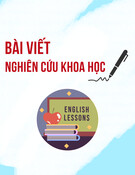



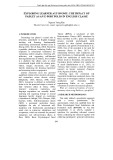

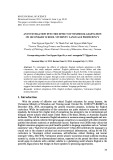
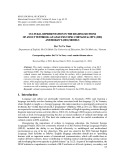

![Tài liệu Từ vựng tiếng Anh Trung cấp [mới nhất]](https://cdn.tailieu.vn/images/document/thumbnail/2025/20250913/nguyentuan250421@gmail.com/135x160/99491757910839.jpg)
![Tài liệu Từ vựng Tiếng Anh theo chủ đề [mới nhất]](https://cdn.tailieu.vn/images/document/thumbnail/2025/20250913/namdhuet@gmail.com/135x160/83251757753810.jpg)


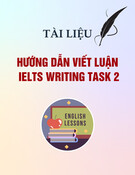
![Tài liệu Từ vựng tiếng Anh cho bé [chuẩn nhất/mới nhất]](https://cdn.tailieu.vn/images/document/thumbnail/2025/20250731/huadaithesang2509@gmail.com/135x160/18631754013896.jpg)









